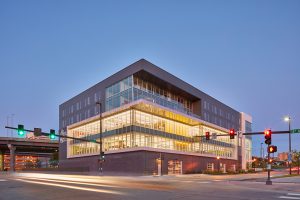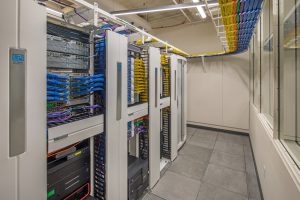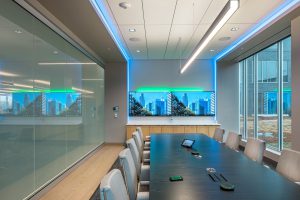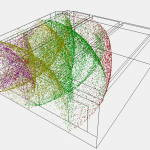What is WiredScore?
Two professionals join LinkedIn every second. The average Facebook user now has about 338 friends. More than 500 million people use Instagram every day. These facts are according to a Google search in the first half of 2019 as the true statistics struggle to keep up with real time.
People are more connected than ever, and that is due in large part to their connection to the internet. It powers news, social media, email, even the Google search that supplied the information above. “Connected” has become one of the most important words in modern society, used daily on almost every level: personal, social, and business. To be able to compete in a market where information can be passed from one side of the globe to the other with the tap of a button, business leaders and entrepreneurs need the most reliable and efficient technology systems.
In the past, the best technology systems were measured by the latest computing software, most pixels, clearest sound, and so on, but as these individual parts continue to advance, a new opportunity for innovation has become apparent: connectivity. Weaving these systems together in such a way as to best utilize each one’s unique strengths creates a superior operation overall. But what is the standard measurement of technology connectivity?
In 2013, New York’s leaders in real estate, technology, and telecommunications came together to answer that question…and the answer was Wired Certification.
What is the Difference Between WiredScore and Wired Certification?
WiredScore is an organization that governs a rating system that gives context to technology connectivity. It is the international ruler by which industry leaders, clients, and consumers measure how capable a building is of supporting and connecting technology systems and users. The WiredScore website states that the standards for evaluation were developed and approved by the New York City Economic Development Corporation and The WiredScore Connectivity Advisory Committee, which is comprised of representatives from industry giants such as Google, Cisco, Spectrum, and the Telecommunications Industry Association.
There are two tracks a building can follow when pursuing Wired Certification: development/redevelopment and occupied structures. While the requirements between the two tracks differ slightly, the rating system for both is broken down into four levels:
- Wired Certified Platinum
- Wired Certified Gold
- Wired Certified Silver
- Wired Certified
Wired Certified Platinum buildings are the definition of superior connectivity and include icons such as Willis Tower and the Empire State Building. In April 2019, Alvine Engineering and IP Design Group’s corporate headquarters in Omaha, Nebraska joined this prestigious list. Not only did the building become Wired Certified Platinum, but it became the first property in Nebraska to be Wired Certified.
What Goes into a Wired Certified Platinum Building?
 WiredScore is a point-based system where a building can earn up to 100 points. For an existing building to reach Wired Certified Platinum, it must earn at least 90 points. Points can be earned in a variety of ways broken down into three main categories – Connectivity, Infrastructure, and Readiness.
WiredScore is a point-based system where a building can earn up to 100 points. For an existing building to reach Wired Certified Platinum, it must earn at least 90 points. Points can be earned in a variety of ways broken down into three main categories – Connectivity, Infrastructure, and Readiness.
The Alvine Engineering and IP Design Group headquarters earned points in connectivity by providing the capacity for multiple service providers, including fixed wireless, and multiple entry points. These measures help to ensure that internet connection is minimally, if at all, impacted by outside forces that may affect data cables.
For instance, if a building’s internet service relied solely on cables running underground on the north side of the building and a water main break necessitated digging that area up, internet connectivity could be lost to the building. For a company that relies on the Cloud to store its data, this loss of internet connectivity could potentially cost a day’s worth of productivity and revenue. However, if the building had another cable entry point on the west side or a fixed wireless connection, then tenants would be able to count on uninterrupted internet connectivity.

The points for infrastructure at the headquarters stress reliability and scalability as the facility incorporates diverse risers, dedicated spaces for service providers’ equipment, and additional space within these equipment areas for future service providers. Risers are essentially conduits or pathways that allow cabling to run throughout a building. By diversifying these pathways and providing a separate room for equipment, it becomes less likely that cabling would be damaged by future construction or tampering.
Readiness focuses on cutting down on the in-the-moment paperwork by rewarding a building with more points for a boiler-plate agreement, like the one put in place at the Alvine Engineering and IP Design Group headquarters. These agreements are in place to allow new service providers to be added more efficiently. For example, if a tenant wants a particular service provider and a boiler-plate agreement has been put in place, that service provider may have permission ahead of time to access certain otherwise restricted areas, enabling quicker installation.
Why Can’t I See the Difference?
 The conduits and cabling in walls and underground are rarely seen physically; however, as soon as a person sits down to a conference call, begins downloading a dense file, or tries to send a hefty email, the speed and/or quality of the transaction is easily noticeable. Employees, partners, and clients can walk into one of the headquarters’ conference rooms and videoconference with anyone in the world at the touch of a button. A reliable remote network connection allows employees to collaborate with the firm’s branch offices across the three states with ease. Any Alvine Engineering or IP Design Group guest can enjoy great internet access with two simple steps.
The conduits and cabling in walls and underground are rarely seen physically; however, as soon as a person sits down to a conference call, begins downloading a dense file, or tries to send a hefty email, the speed and/or quality of the transaction is easily noticeable. Employees, partners, and clients can walk into one of the headquarters’ conference rooms and videoconference with anyone in the world at the touch of a button. A reliable remote network connection allows employees to collaborate with the firm’s branch offices across the three states with ease. Any Alvine Engineering or IP Design Group guest can enjoy great internet access with two simple steps.
What are the Benefits of Wired Certification?
Internet connectivity is among the top three things tenants consider when looking for viable office space. Wired Certification is an easy way for potential tenants to see exactly what technology integration and features they can expect from a potential office space. Providing convenient and transparent information encourages communication between owners and tenants, which can attract tenants that want to lease for longer terms. As an added benefit, the Wired Certified seal is distinct and easy to spot, so it can help a building stand out from the competition.
Today, technology seems to become obsolete almost the day it is created, which can make keeping up with it both difficult and expensive. This is especially true for buildings that often have to undergo costly renovations in order to accommodate future technology. Wired Certification addresses future-proofing throughout its process to aid in providing top-of-the-line connectivity today and tomorrow.
Once tenants and office leaders experience the increased efficiency of integrated technology systems, it tends to become their new standard, and they will not settle for anything less. WiredScore provides the guidance for both owners and clients to stay connected in today’s fast-paced environment, and in the years to come.
Where Can I Learn More?
For more information about Wired Certification, Wired Certified buildings, case studies, and resources visit WiredScore’s website.
To see how the features of Alvine Engineering and IP Design Group’s corporate headquarters translated into Wired Certification, view the online fact sheet. For the definitions associated with these facts, click “Print Fact Sheet” at the top.
*Photos by Kessler Photography









